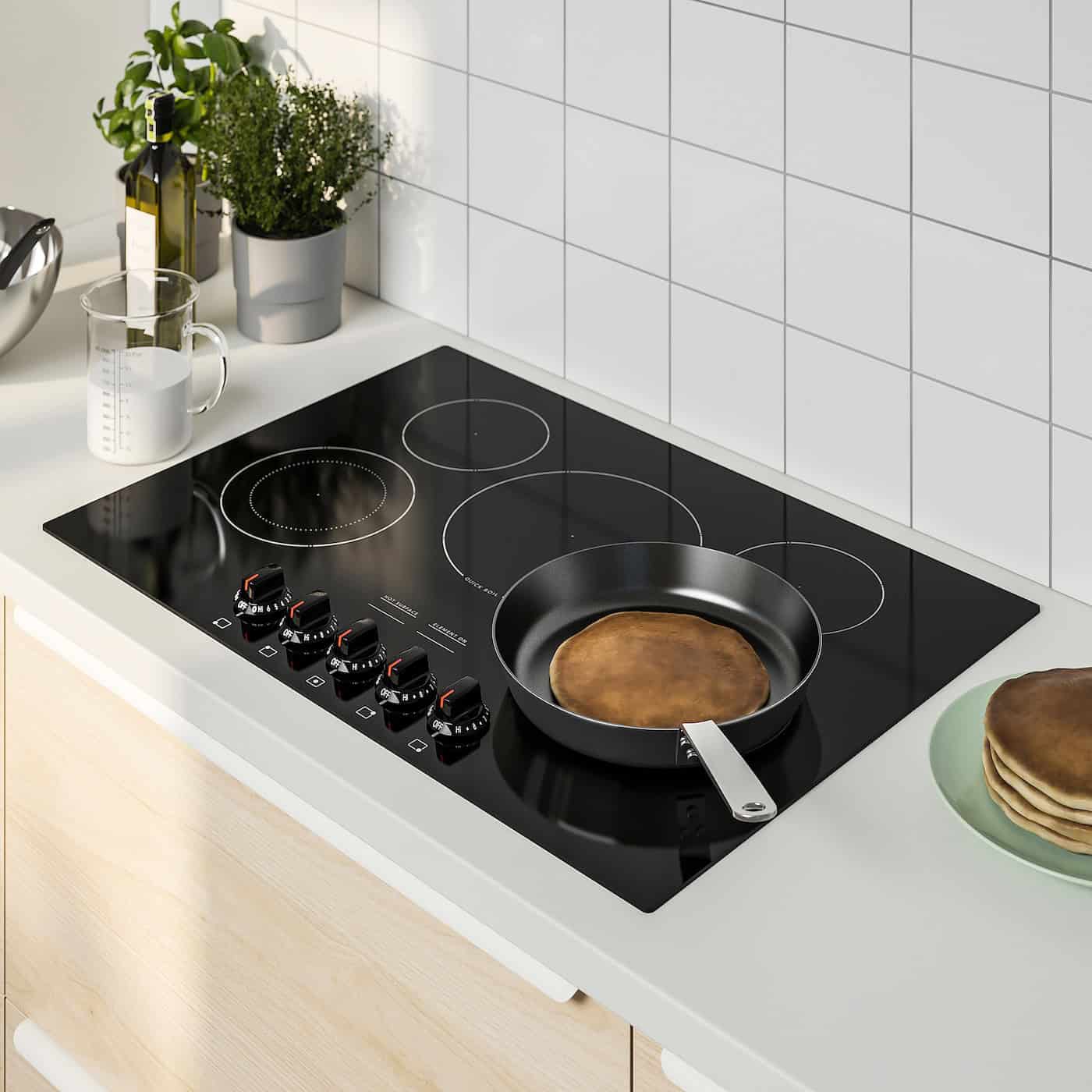Glass electric cooktops have gained popularity in modern kitchens. They offer a sleek look and easy cleaning compared to traditional coil stoves. These cooktops heat up faster and provide even cooking. However, their glass surface can be prone to cracking, which poses safety risks and may render the appliance unusable.
Cracked glass cooktops are a common issue for many homeowners. Understanding the causes of cracks and how to prevent them is crucial for maintaining these appliances. This article explores repair options, replacement costs, and preventive measures to keep glass cooktops in top condition. It also addresses whether it’s safe to use a cracked cooktop and provides tips for prolonging the life of these kitchen fixtures.
Understanding Cooktop Glass Damage
Common Causes of Cracks
Cracked glass on an electric cooktop is a common household issue. Several factors can cause these cracks. One frequent cause is impact. Dropping a heavy pot or pan onto the cooktop can easily cause damage. Even a light drop can create a weak spot. This can later develop into a crack. Thermal shock is another culprit. This happens when the glass experiences sudden temperature changes. For example, placing a cold dish on a hot burner can cause this. Spilling cold water on a hot surface can also do it. Improper cleaning can also contribute. Using harsh abrasives or scrub pads can scratch the glass. These scratches weaken the surface, making it more prone to cracking. Sometimes, manufacturing flaws in the glass are the cause, though this is less common.
What to Do When a Crack Appears
If you notice a crack, stop using the cooktop right away. This is important for safety. Using a cracked cooktop can worsen the damage. It can also create a safety hazard. Turn off the power to the cooktop at the circuit breaker. This prevents any risk of electric shock. Assess the damage. Is it a small hairline crack? Or is it a large, spreading one? Do not try to repair it yourself. Using glue or sealant is not a safe or lasting fix. It can also void any warranty. Contact a qualified appliance repair technician. They can assess the damage. They can tell you if the glass can be replaced, or if you need a new cooktop.
Repairing a cracked glass cooktop yourself is strongly discouraged due to significant safety risks:
- Electric Shock Hazard: A cracked cooktop exposes electrical components, creating a serious risk of electric shock, especially if liquids are spilled.
- Further Damage and Injury: Attempting a repair could worsen the crack, causing the glass to shatter during use, which could lead to cuts and burns.
- Voiding Warranty: DIY repairs will almost certainly void any existing warranty on your cooktop.
- Ineffective Repairs: DIY methods like using glue or sealants are temporary at best and do not restore the structural integrity of the glass. They can also create uneven heating and further damage.
Safety First
A cracked cooktop is a safety concern. It can pose an electric shock risk. Especially if liquids spill on it. Using it with a crack can cause the glass to shatter. This creates a mess and potential danger. It’s important to take the necessary precautions.
Prevention Tips
There are ways to prevent cracks. Use the right cookware. Use pots and pans with smooth, flat bottoms. This ensures even heat distribution. Be careful with heavy objects. Avoid dropping anything on the cooktop. Clean it properly. Use a cleaner designed for glass cooktops. Avoid harsh chemicals and abrasive scrubbers. Try to avoid extreme temperature changes. Don’t put cold things on hot surfaces. These simple steps can help protect your cooktop.
Troubleshooting and Prevention Summary
| Issue | Cause | Prevention/Action |
|---|---|---|
| Cracked Glass | Impact, thermal shock, improper cleaning, manufacturing defect | Use proper cookware, handle objects carefully, clean with appropriate products, avoid extreme temperature changes, stop using the cooktop and turn off the power, contact a repair technician |
Key Takeaways
- Glass cooktops can crack due to thermal stress or impact
- Repair or replacement options vary based on the extent of damage
- Regular maintenance and proper use help prevent cracks in glass cooktops
Why Do Glass Cooktops Break?
Glass cooktops can crack due to several factors. Sudden temperature changes often lead to thermal shock, weakening the surface. Heavy pots or utensils dropping on the cooktop may cause impact damage. Some cracks stem from manufacturing flaws in the glass itself.
Uneven weight distribution from large cookware can stress the surface. Over time, small scratches may develop into larger cracks. Excessive heat from malfunctioning burners or spilled food creating hot spots can also damage the glass.
• Use appropriately sized cookware
• Avoid dragging pots across the surface
• Clean spills promptly to prevent hot spots
• Allow the cooktop to cool gradually
Proper care helps prevent cracks and extends the life of glass cooktops.
Is It Safe to Use a Cracked Glass Stove Top?
Using a cracked glass cooktop poses significant risks. Even small cracks can lead to electric shock hazards. While minor cracks might be repairable, larger ones often require a full replacement.
Safety precautions for cracked stove tops:
- Avoid using the damaged burner
- Keep liquids away from the crack
- Unplug the stove when not in use
- Schedule a professional inspection
Replacing the glass-ceramic surface is crucial for safety. Don’t delay repairs, as cracks can worsen over time.
Repairing Cracked Glass Cooktops: Cost Considerations
Replacing a damaged glass cooktop can be costly. Prices vary based on brand, type, and model. A new cooktop panel typically costs between $200 and $1000, not including installation fees.
Gas, electric, and induction cooktops have different price points. Larger cooktops generally cost more. Brand and manufacturer also impact the final price.
When selecting a repair service, consider the warranty offered. Some companies provide up to one year of coverage on parts and labor.
Key factors affecting repair costs:
- Cooktop type (gas, electric, induction)
- Size of the cooktop
- Brand and model
- Warranty coverage
Before deciding to repair, compare the cost to buying a new unit. For expensive models, repairs may be more cost-effective. Electric smoothtop cooktops with higher initial prices often justify repair costs.
Always consult a professional to assess the damage and provide an accurate estimate. This helps in making an informed decision between repair and replacement.
Fixing a Damaged Glass Cooktop
Glass cooktops are durable but not indestructible. Cracks can occur due to impacts, heat stress, or sudden temperature changes. While small chips may seem minor, they can spread over time, compromising the cooktop’s integrity.
Assessing the damage is crucial. Small chips or scratches might be fixable, but larger cracks often require professional help. Here’s a guide to addressing common issues:
For minor scratches:
- Clean the area thoroughly
- Apply a glass cooktop cleaner
- Buff gently with a soft cloth
For small chips:
- Use a specialized touch-up kit
- Follow the kit instructions carefully
- Allow 24 hours for the repair to set
For deeper scratches:
- Try a glass polishing compound
- Apply in circular motions
- Wipe clean and assess results
It’s important to note that DIY repairs have limitations. Epoxy and other adhesives may not withstand high temperatures, making them unsuitable for long-term fixes.
Prevention is key to maintaining a glass cooktop:
• Use flat-bottomed cookware
• Avoid dragging pots and pans
• Clean spills promptly
• Don’t use the surface as a cutting board
For significant cracks or extensive damage, replacement is often the safest option. Professional repair services can assess the damage and provide expert advice on whether repair or replacement is necessary.
Remember, a damaged cooktop can pose safety risks. If unsure about the extent of the damage or repair methods, consult a professional. Regular maintenance and careful use will help extend the life of your glass cooktop and prevent costly repairs.
Replacing a Damaged Glass Cooktop
A cracked or scratched glass cooktop doesn’t always mean buying a new stove. With careful steps, you can replace just the glass surface. This guide walks you through the process.
Safety first:
- Turn off power to the stove
- Gather proper tools and safety equipment
Remove the old cooktop:
- Unscrew mounting brackets
- Lift cooktop and place on counter
- Disconnect wire harness for controls
Install new glass surface:
- Place new top on burner box
- Reconnect control wires
- Secure with screws
Finish installation:
- Lower cooktop into counter
- Reattach mounting brackets
- Restore power
Glass cooktop cracks can happen for various reasons. Thermal shock, impact from heavy objects, or manufacturing defects may cause damage. Replacing the glass yourself can save money compared to buying a new stove.
The cost to replace a glass stove top is around $200. This is much less than a new stove, which can cost over $1,000. However, DIY replacement isn’t right for everyone.
Consider these factors before attempting a glass cooktop replacement:
- Skill level: Are you comfortable with basic appliance repair?
- Tools: Do you have the right equipment?
- Time: Can you dedicate a few hours to the project?
- Warranty: Will DIY repair void any existing warranty?
For those unsure about tackling this job, professional help is available. Certified technicians can ensure proper installation and maintain any warranties.
Gas stove owners should note: Glass cooktop replacement on gas ranges requires special skills. Only attempt this with proper training and certifications for gas appliance repair.
Remember, working with electrical appliances carries risks. If you’re uncertain about any step in the process, it’s best to seek professional help. Safety should always be the top priority when dealing with home appliances.
Getting a Free Quote for Stove Glass Top Replacement
When a glass cooktop cracks or sustains damage, swift action is crucial. Contacting a professional appliance repair service can provide a clear path forward. Many companies offer no-cost estimates for glass top replacement. To obtain a quote, customers typically need to:
- Call the repair service
- Provide appliance details:
- Brand
- Model number
- Serial number
This information helps technicians check part availability and estimate repair timelines. After receiving the quote, customers can schedule an appointment for part delivery and installation if they choose to proceed.
Benefits of getting a free estimate:
- Understand repair costs upfront
- Learn about part availability
- Plan budget and timing for repairs
Prompt action on glass top damage can prevent further issues and restore the stove’s functionality quickly.
Protecting Your Glass Cooktop from Damage
Proper care and usage can extend the life of a glass cooktop. Selecting the right cookware is crucial. Lightweight pots and pans with smooth, flat bottoms made of stainless steel or heavy-duty aluminum are ideal. Avoid copper and enameled pots, as they may leave residue that can harm the surface. Cast iron, porcelain, and ceramic cookware are also risky due to their weight and rough bottoms.
Clean-up habits play a key role in cooktop maintenance:
• Wipe spills promptly after cooking
• Let the cooktop cool completely before cleaning
• Use only suitable cleaning agents
To keep your glass cooktop in top shape:
- Never slide cookware across the surface
- Avoid storing heavy items above the stove
- Keep cookware bottoms clean
- Follow manufacturer instructions carefully
- Use only non-abrasive cleaners and soft cloths
Choosing the right cookware is vital. Here’s a quick guide:
| Good Choices | Avoid |
|---|---|
| Stainless steel | Cast iron |
| Heavy-duty aluminum | Ceramic |
| Flat-bottomed pots | Copper |
| Lightweight pans | Enameled pots |
Regular cleaning helps prevent damage. After each use, wait for the cooktop to cool. Then, use a soft cloth with a mild cleaner made for glass surfaces. Harsh scrubbers or abrasive cleaners can scratch the glass, leading to future cracks.
Heat management is another key factor. Avoid placing cold items on a hot cooktop or hot pans on a cold surface. This thermal shock can cause cracking. Always lift pots and pans instead of sliding them. This prevents scratches that can weaken the glass over time.
Be mindful of what you place on or above your cooktop. Heavy objects stored overhead pose a risk if they fall. Even small drops can chip or crack the glass. Keep the area above your stove clear of heavy items like microwaves or storage containers.
Proper cooking techniques also matter. Don’t let pots boil dry, as this can create hot spots that stress the glass. Always use the right size burner for your cookware to ensure even heat distribution.
By following these tips, you can keep your glass cooktop looking great and functioning well for years to come. Regular care and smart choices in cookware and cleaning methods will help prevent cracks, chips, and other damage.







